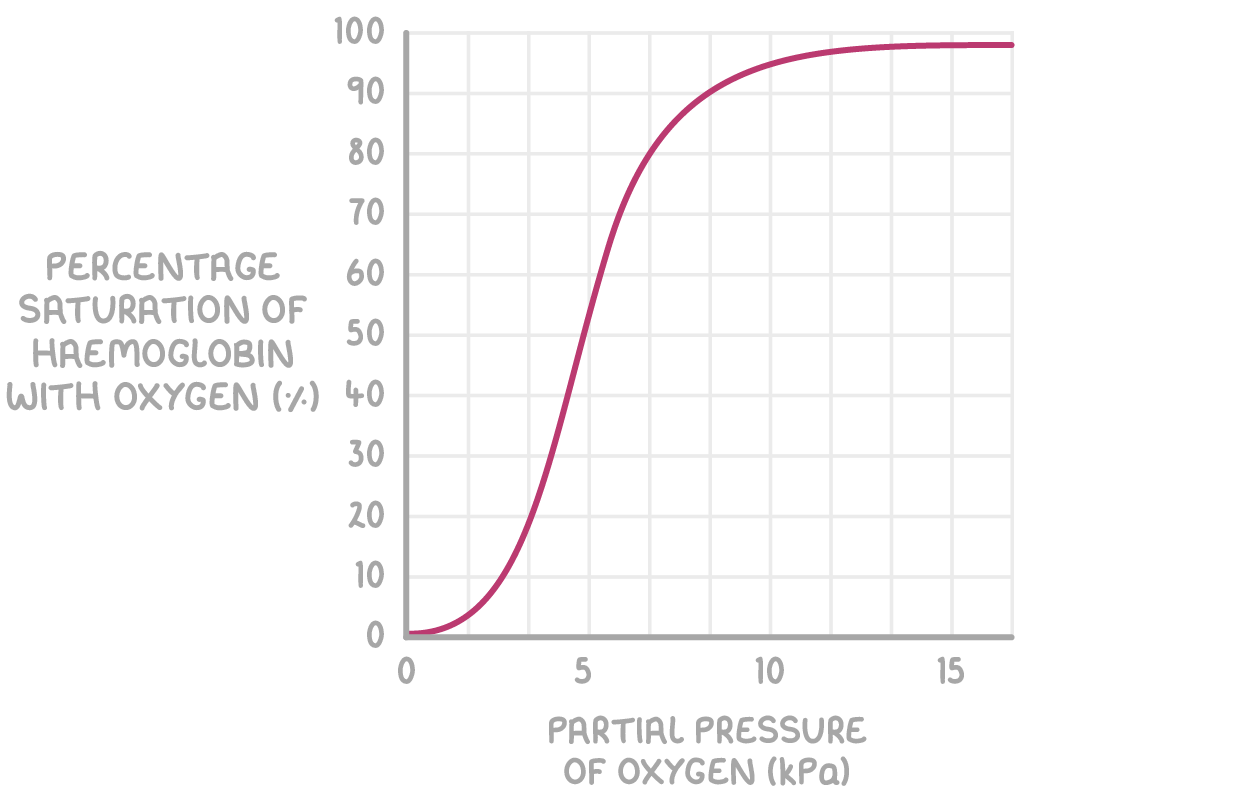oxidation curve
1/13
There's no tags or description
Looks like no tags are added yet.
Name | Mastery | Learn | Test | Matching | Spaced |
|---|
No study sessions yet.
14 Terms
describe haemoglobin
Haemoglobin is made up of 2 different types of subunits A and B there are 2 of each of these types so in total 4. Each subunit has the prosthetic group haem attached. Within the haem group there is the Fe2+ ion which oxygen can bind to
what is the equation for oxygen binding (loading) and unbinding (unloading)
Hb+4O2=Hb(O2)4 this is a reversible reaction
what does affinity mean
How strongly the oxygen is bound the haemoglobin

what is this called
What is the partial pressure
what is this type of curve called
oxygen dissociation curve
basically the concentration of oxygen
sigmodal
describe what happens in the graph
As we increase the partial pressure of oxygen the percentage saturation increases very slowly at around 4KPa the rate of saturation begins to increase. The haemoglobin is 25% saturated. At around 7 KPa and 75% saturation (2 oxygen molecules have joined) the rate of saturating begins to slow.
Explain the oxygen dissociation curve
Its hard for the first oxygen molecules to bind to one of the four sites on haemoglobin because the polypeptide subunits are closely held together so its hard for the oxygen molecule to access the Fe2+ ion. Therefore at a low practical pressure little oxygen binds to haemoglobin so the curve is shallow.
Once an oxygen binds to the haemoglobin it changes the quaternary structure of the haemoglobin. the globin chains open up so that the second and third oxygen molecules can bind easier to Fe2+ ions. Only a small increase in partial pressure causes lots more oxygen to bind
Due to the haemoglobin being almost fully saturated (there are less spaces for O2 to collide with and bind) Its harder for it to bind to an Fe2+ ion. This cause the gradient of the curve to decrease and plateaus. When the partial pressure of oxygen is lower than the atmospheric pressure of 21KPa haemoglobin is normally fully saturated
There abouts is the blood when its at its highest percentage saturation
alveoli
where is the blood going to as this saturation drops
tissue
what is a factor that effects the graph
carbon dioxide

Describe the difference between low and high level of CO2 and what that mean for the affinity of oxygen
high levels of CO2 cause the oxygen dissociation curve to shift the right. CO2 causes the oxygen affinity of haemoglobin to decrease. So its easier to loose the oxygen
what is the shift right called
Bohr effect
How does CO2 cause the structure of the haemoglobin to change
In the blood carbon dioxide can firm the acidic molecule carbonic acid. This releases the hydrogen ion H+. This H+ combines with the haemoglobin and causes it to change its quaternary structure. This results in haemoglobin having a lower affinity for oxygen.
What is the affinity of haemoglobin
The foetus obtains its oxygen from the mothers blood. The foetal haemoglobin has a much higher haemoglobin affinity for oxygen at a low partial pressure so its oxygen dissociation curve is shifted to the right. This allows the oxygen to unload from mothers blood and diffuse into the foetus blood . foetal haemoglobin is slowly replaced in the first
what is a myoglobin
Myoglobin is a protein found only in muscle cells. It is like a single haemoglobin chain, with a single haem group, and it also binds oxygen. It is myoglobin that gives red meat its colour. As the dissociation curve shows, myoglobin has a higher affinity for oxygen, especially at low partial pressures. So in muscle cells oxygen will unload from haemoglobin and bind to myoglobin. Oxygen will only be unloaded from myoglobin at very low partial pressures, when muscle cells are respiring rapidly. So myoglobin acts as an oxygen store, making oxygen available when needed